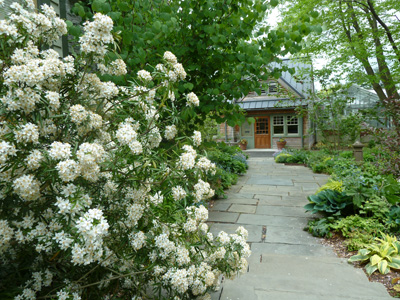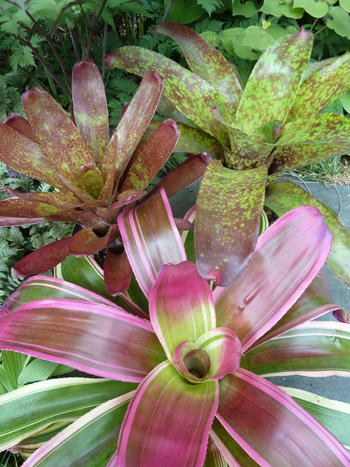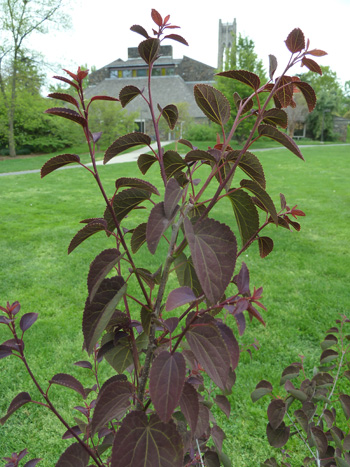Plants of the Week: May 13
 Choisya is a member of Rutaceae. Others in the family include citrus species and Skimmia. The plants within this family have oil glands within the leaves which when crushed are highly aromatic; the flowers are also highly scented. Choisya is commonly known as Mexican orange blossom and this is a very good description as the flowers have a distinct citrus fragrance. These flowers are abundant in nectar, providing good food for bees. Star-shaped white flowers are produced in late spring and again in late summer and autumn. These are borne on terminal or axillary cymes or corymbs of 3-6 flowers. The cultivar C. x dewitteana ‘Aztec Pearl’ was bred in 1982 by Peter Moore for Hillier nurseries; it is a cross between C. ternata and C. dumosa var. arizonica and the first hybrid in the genus. Choisya x dewitteana ‘Aztec Pearl’ has proven to be a reliable performer in the Terry Shane Teaching Garden. Photo credit: J.Coceano
Choisya is a member of Rutaceae. Others in the family include citrus species and Skimmia. The plants within this family have oil glands within the leaves which when crushed are highly aromatic; the flowers are also highly scented. Choisya is commonly known as Mexican orange blossom and this is a very good description as the flowers have a distinct citrus fragrance. These flowers are abundant in nectar, providing good food for bees. Star-shaped white flowers are produced in late spring and again in late summer and autumn. These are borne on terminal or axillary cymes or corymbs of 3-6 flowers. The cultivar C. x dewitteana ‘Aztec Pearl’ was bred in 1982 by Peter Moore for Hillier nurseries; it is a cross between C. ternata and C. dumosa var. arizonica and the first hybrid in the genus. Choisya x dewitteana ‘Aztec Pearl’ has proven to be a reliable performer in the Terry Shane Teaching Garden. Photo credit: J.Coceano
Garden location: Terry Shane Teaching Garden
 The more I work with, tend to, and grow bromeliads, the more I come to appreciate this diverse group of plants. The classification of “tropical” can be a bit intimidating and lead one to believe they are finicky. Not so! Bromeliads, particularly the various Neoregelia offered at the upcoming Unusual Tropicals and Annuals Sale, work great planted in containers or in ground. Neoregelia are easy to care for houseplants during the winter months. As an added bonus, most cultivars are prolific bearers of offsets or pups allowing one to increase their holdings or share with friends. Photo credit: J. Coceano
The more I work with, tend to, and grow bromeliads, the more I come to appreciate this diverse group of plants. The classification of “tropical” can be a bit intimidating and lead one to believe they are finicky. Not so! Bromeliads, particularly the various Neoregelia offered at the upcoming Unusual Tropicals and Annuals Sale, work great planted in containers or in ground. Neoregelia are easy to care for houseplants during the winter months. As an added bonus, most cultivars are prolific bearers of offsets or pups allowing one to increase their holdings or share with friends. Photo credit: J. Coceano
Garden Location: seasonal displays
 According to Broken Arrow Nursery Magnolia denudata ‘Fran Smith’ is “about as hard to find as a chicken with teeth.” Why so elusive? ‘Fran Smith’ sports a subtle but relatively stable variegation known to hold up much better than other variegated magnolias in sunny locations. Cream blushed flowers open before the foliage emerges. Photo credit: J. Coceano
According to Broken Arrow Nursery Magnolia denudata ‘Fran Smith’ is “about as hard to find as a chicken with teeth.” Why so elusive? ‘Fran Smith’ sports a subtle but relatively stable variegation known to hold up much better than other variegated magnolias in sunny locations. Cream blushed flowers open before the foliage emerges. Photo credit: J. Coceano
Garden location: in front of Ben West House/Public Safety building
 Cercidiphyllum japonicum ‘Rotfuchs’ sports leaves which are deep purple when they emerge in spring, gradually transitioning to glaucous blue as the year progresses. The very narrow, upright habit of this deciduous tree is said to resemble a fox’s tail when mature. The name ‘Rotfuchs’ means “red fox” in German. The vertical habit makes this tree a good choice for smaller gardens. Photo credit: J. Coceano
Cercidiphyllum japonicum ‘Rotfuchs’ sports leaves which are deep purple when they emerge in spring, gradually transitioning to glaucous blue as the year progresses. The very narrow, upright habit of this deciduous tree is said to resemble a fox’s tail when mature. The name ‘Rotfuchs’ means “red fox” in German. The vertical habit makes this tree a good choice for smaller gardens. Photo credit: J. Coceano
Garden Location: Pinetum





No Comments